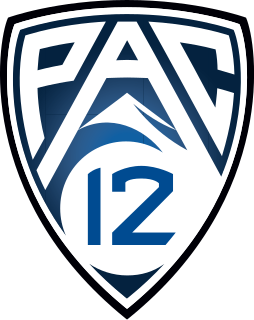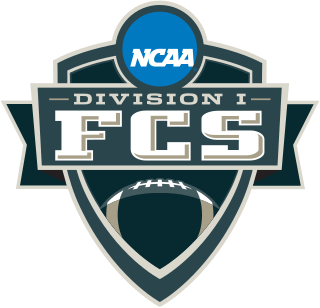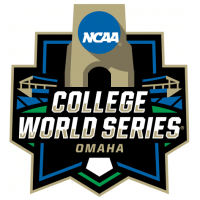Related Research Articles

The Pac-12 Conference is a collegiate athletic conference, that operates in the Western United States, participating in 24 sports at the NCAA Division I level. Its football teams compete in the Football Bowl Subdivision, the highest level of college football in the nation.

The NCAA Division I Football Championship is an annual post-season college football game, played since 2006, used to determine a national champion of the NCAA Division I Football Championship Subdivision (FCS). From 1978 to 2005, the game was known as the NCAA Division I-AA Football Championship.

The College World Series (CWS), officially the NCAA Men's College World Series (MCWS), is an annual baseball tournament held in June in Omaha, Nebraska. The MCWS is the culmination of the National Collegiate Athletic Association (NCAA) Division I Baseball Championship tournament—featuring 64 teams in the first round—which determines the NCAA Division I college baseball champion. The eight participating teams are split into two, four-team, double-elimination brackets, with the winners of each bracket playing in a best-of-three championship series.
A mythical national championship is national championship recognition that is not explicitly competitive. This phrase has often been invoked in reference to American college football, because the NCAA does not sponsor a playoff-style tournament or recognize official national champions for the Football Bowl Subdivision. The relevant recognition before 1998 came from various entities, including coach polls and media ballots, which each voted to recognize their own national champions, and is similar to the newspaper decision used in early boxing matches. The contrary term would be an undisputed national championship.
The NCAA Division I Baseball Championship is held each year from May through June and features 64 college baseball teams in the United States, culminating in the eight-team College World Series at TD Ameritrade Park Omaha in Omaha, Nebraska.
The 1952 College World Series was the sixth NCAA-sanctioned baseball tournament that determined a national champion. The tournament was held as the conclusion of the 1952 NCAA baseball season and was played at Johnny Rosenblatt Stadium in Omaha, Nebraska from June 12 to June 17. The tournament's champion was the Holy Cross Crusaders, coached by Jack Barry. The Most Outstanding Player was James O'Neill of Holy Cross.
The 1947 NCAA Baseball Tournament was the first NCAA-sanctioned baseball tournament that determined a national champion. The tournament was held as the conclusion of the 1947 NCAA baseball season, beginning on June 20. The 1947 College World Series was played at Hyames Field on the campus of Western Michigan University in Kalamazoo, Michigan from June 27 to June 28. The first tournament's champion was California, coached by Clint Evans.
The 1950 College World Series was the fourth NCAA-sanctioned baseball tournament that determined a national champion. The tournament was held as the conclusion of the 1950 NCAA baseball season and was played at Johnny Rosenblatt Stadium in Omaha, Nebraska from June 15 to June 23. It was the first College World Series to be held at the stadium, which hosted the event through 2010. The tournament's champion was the Texas Longhorns, coached by Bibb Falk. The Most Outstanding Player was Ray VanCleef of Rutgers. The championship was the second consecutive for the Longhorns.
The 1953 College World Series was the seventh NCAA-sanctioned baseball tournament that determined a national champion. The tournament was held as the conclusion of the 1953 NCAA baseball season and was played at Johnny Rosenblatt Stadium in Omaha, NE from June 11 to June 16. The tournament's champion was Michigan, coached by Ray Fisher. The Most Outstanding Player was J. L. Smith of Texas.
The 1949 NCAA Baseball Tournament was the third NCAA-sanctioned baseball tournament that determined a national champion. The tournament was held as the conclusion of the 1949 NCAA baseball season. The College World Series was played at Wichita Municipal Stadium in Wichita, Kansas from June 22 to June 25. The third tournament's champion was the Texas Longhorns, coached by Bibb Falk. The Most Outstanding Player was named for the first time, with the inaugural award going to Tom Hamilton of Texas. This was the first of six championships for the Longhorns through the 2019 season.
The 1954 NCAA Baseball Tournament was played at the end of the 1954 NCAA baseball season to determine the national champion of college baseball. The tournament concluded with eight teams competing in the College World Series, a double-elimination tournament in its eighth year. Eight regional districts sent representatives to the College World Series, but for the first time the preliminary tournament rounds hosted by each district were sanctioned NCAA events. These events would later become known as regionals. Each district had its own format for selecting teams, resulting in 24 teams participating in the tournament at the conclusion of their regular season, and in some cases, after a conference tournament. The College World Series was held in Omaha, NE from June 10 to June 16. The eighth tournament's champion was Missouri, coached by John "Hi" Simmons. The Most Outstanding Player was Tom Yewcic of Michigan State.
The 1955 NCAA Baseball Tournament was played at the end of the 1955 NCAA baseball season to determine the national champion of college baseball. The tournament concluded with eight teams competing in the College World Series, a double-elimination tournament in its ninth year. Eight regional districts sent representatives to the College World Series with preliminary rounds within each district serving to determine each representative. These events would later become known as regionals. Each district had its own format for selecting teams, resulting in 25 teams participating in the tournament at the conclusion of their regular season, and in some cases, after a conference tournament. The College World Series was held in Omaha, NE from June 10 to June 16. The ninth tournament's champion was Wake Forest, coached by Taylor Sanford. The Most Outstanding Player was Tom Borland of Oklahoma A&M.
The 1958 NCAA University Division Baseball Tournament was played at the end of the 1958 NCAA University Division baseball season to determine the national champion of college baseball. The tournament concluded with eight teams competing in the College World Series, a double-elimination tournament in its twelfth year. Eight regional districts sent representatives to the College World Series with preliminary rounds within each district serving to determine each representative. These events would later become known as regionals. Each district had its own format for selecting teams, resulting in 26 teams participating in the tournament at the conclusion of their regular season, and in some cases, after a conference tournament. The College World Series was held in Omaha, NE from June 13 to June 19. The twelfth tournament's champion was Southern California, coached by Rod Dedeaux. The Most Outstanding Player was Bill Thom of Southern California.
A national championship in the highest level of college football in the United States, currently the NCAA Division I Football Bowl Subdivision (FBS), is a designation awarded annually by various organizations to their selection of the best college football team. Division I FBS football is the only National Collegiate Athletic Association (NCAA) sport for which the NCAA does not sanction a yearly championship event. As such, it is sometimes unofficially referred to as a "mythical national championship".
The 1991 NCAA Division I Baseball Tournament was played at the end of the 1991 NCAA Division I baseball season to determine the national champion of college baseball. The tournament concluded with eight teams competing in the College World Series, a double-elimination tournament in its forty fifth year. Eight regional competitions were held to determine the participants in the final event. Each region was composed of six teams, resulting in 48 teams participating in the tournament at the conclusion of their regular season, and in some cases, after a conference tournament. The forty-fifth tournament's champion was LSU, coached by Skip Bertman. The Most Outstanding Player was Gary Hymel of LSU.
The 1968 NCAA University Division Baseball Tournament was played at the end of the 1968 NCAA University Division baseball season to determine the national champion of college baseball. The tournament concluded with eight teams competing in the College World Series, a double-elimination tournament in its twenty-second year. Eight regional districts sent representatives to the College World Series with preliminary rounds within each district serving to determine each representative. These events would later become known as regionals. Each district had its own format for selecting teams, resulting in 27 teams participating in the tournament at the conclusion of their regular season, and in some cases, after a conference tournament. The twenty-second tournament's champion was the Southern California, coached by Rod Dedeaux. The Most Outstanding Player was Bill Seinsoth of the Southern California.
The 1947 NCAA baseball season, play of college baseball in the United States organized by the National Collegiate Athletic Association (NCAA) began in the spring of 1947. The season progressed through the regular season and concluded with the 1947 NCAA Baseball Tournament and 1947 College World Series. The College World Series, held for the first time in 1947, consisted of the two remaining teams in the NCAA Tournament and was held in Kalamazoo, Michigan at Hyames Field as a best of three series. California claimed the championship two games to none over Yale.
The 1948 NCAA baseball season, play of college baseball in the United States organized by the National Collegiate Athletic Association (NCAA) began in the spring of 1948. The season progressed through the regular season and concluded with the 1948 NCAA Baseball Tournament and 1948 College World Series. The College World Series, held for the second time in 1948, consisted of the two remaining teams in the NCAA Tournament and was held in Kalamazoo, Michigan at Hyames Field as a best of three series. Southern California claimed the championship two games to one over Yale.

The annual NCAA Division I Men's Ice Hockey Tournament is a college ice hockey tournament held in the United States by the National Collegiate Athletic Association (NCAA) to determine the top men's team in Division I. Like other Division I championships, it is the highest level of NCAA men's hockey competition.
The 1953 NCAA baseball season, play of college baseball in the United States organized by the National Collegiate Athletic Association (NCAA) began in the spring of 1953. The season progressed through the regular season and concluded with the 1953 College World Series. The College World Series, held for the seventh time in 1953, consisted of one team from each of eight geographical districts and was held in Omaha, Nebraska at Johnny Rosenblatt Stadium as a double-elimination tournament. Michigan claimed the championship.
References
- ↑ "1948 College World Series". Omaha.com. Archived from the original on December 26, 2011. Retrieved August 31, 2019.
- ↑ Woody Anderson (May 31, 1996). "At The Inaugural Series, A President In The Lineup". Hartford Courant. Retrieved July 11, 2012.
- ↑ 2012 Record Book (PDF). Illinois University. p. 79. Retrieved July 11, 2012.
- ↑ 2012 Yearbook. goheels.com. p. 87. Retrieved July 12, 2012.
- ↑ 2009 Media Guide (PDF). Lafayette Leopards. p. 19. Retrieved July 12, 2012.
- ↑ 2012 USC Baseball Guide (PDF). USC. p. 94. Retrieved July 12, 2012.
- ↑ 2012 Baseball Media Guide. okstate.com. p. 59. Archived from the original on July 4, 2012. Retrieved July 12, 2012.
- ↑ 2012 Baseball Media Almanac (PDF). BaylorBears.com. p. 81. Retrieved July 12, 2012.